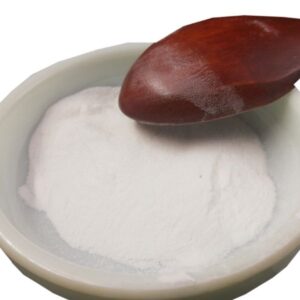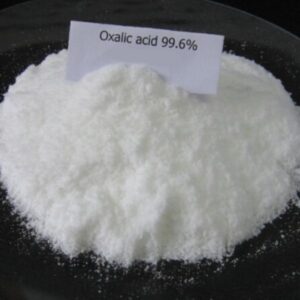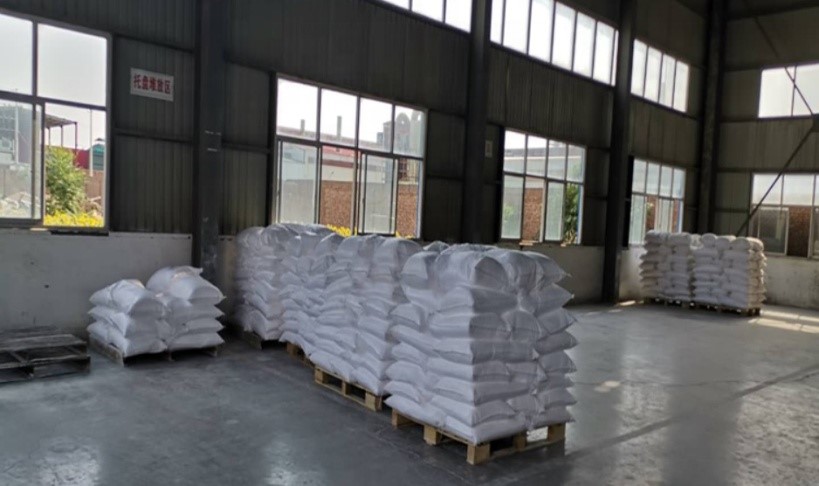1. What is Oxalic acid?
Oxalic acid is an organic acid having greater acidic strength than other weak acids like acetic acids. It is an Industrial Chemical and can be found naturally and can be manufactured in labs as well.

Oxalic Acid
2. What is Oxalic acid used for?
Oxalic acid has varieties of household as well as industrial uses.
- It is used as a mordant in about 25% of dying treatments.
- The aqueous solution of oxalic acid is used to remove tannin stains from wooden surfaces and rust from metal surfaces quickly and effectively.
- It is utilized in the development of photographic film.
- It is used in the electron industry to make chemical raw materials for porcelain capacitors and to make electron equipment detergent.
- It’s also a key component in certain teeth whitening products.
- It is incorporated in extractive metallurgy as it is an excellent reducing agent.
- It is used to remove calcium from wastewater in wastewater treatment.
- Oxalic acid is also employed as a grinding agent while polishing marble.
3. What is the Chemical Formula of Oxalic acid?
Oxalic acid exists in its dihydrate form with the chemical formula C2H2O4.2H2O.
4. Is Oxalic acid harmful to life?
At moderate concentrations, oxalic acid is safe to use for a variety of purposes. However, at large concentrations, it is extremely hazardous.
It can cause irritation to skin, eye and mucous membrane due to its toxic and hazardous nature. Owing to it being a toxic chemical, having prolonged skin contact or swallowing it accidentally can be lethal to human life.
5. Where is Oxalic acid found? What does Oxalic acid looks like?
It is an organic compound found in many plants such as green vegetables, fruits, cocoa, nuts, seeds, etc where they are bound to minerals, forming oxalate. In factories, oxalic acid is made by the oxidation of glucose in the presence of nitric acid or by carboxylation of alcohol. Moreover, some soil fungi are also found to produce oxalic acids.
Oxalic acids are white transparent crystalline solids that are odorless and form colorless solutions in water.

Oxalic Acid
6. What are Hazardous effects of Oxalic acid?
Other than that, extended or recurrent contact with Oxalic Acid can result in skin rashes, skin discomfort, redness, blisters, and slow ulcer.
7. What are precautionary measures necessary to be taken to handle Oxalic acid?
To avoid any unintended consequences, proper oxalic acid storage and disposal must be considered. When handling this chemical, safe industrial hygiene standards should be followed and protective equipment should be worn.

Precautionary measure of Oxalic Acid
8. What will happen if Oxalic acid is heated?
On heating, oxalic acid first loses its water of crystallization and then decomposes into carbon dioxide (CO2), carbon monoxide (CO), and water (H2O).
9. Is Oxalic acid a soluble compound?
Oxalic acid has two hydroxyl groups and forms two hydrogen bonds with water molecules, making it soluble in water. They are also soluble in ethanol and ether, but only at a certain temperatures and concentrations.
10. Where can I buy Oxalic acid?
It is available to be shipped in 25kg woven bags or in 100kg woven jumbo bags. We sell oxalic acid to our clients worldwide in 20FT containers. Camachem has been directly exporting oxalic acid from China to the rest of the world for over a decade.

Oxalic Acid Packaging
11. How much does Oxalic acid cost?
The price of Oxalic Aacid is affected by the cost of raw materials used in the manufacturing process. The estimated cost per tonne is $1000.00.

Oxalic Acid cost
12. What is PH of Oxalic acid?
Oxalic acid is polyprotic acid with a variable PH range. The lowest PH found is 1.25 and the highest PH is found to be 4.14.
13. Is Oxalic acid an Electrolyte compound?
It partially ionizes in an aqueous solution and can be used as a single anodizing electrolyte in a concentration from 3% to 10% by weight.
14. Can Oxalic acid go down the drain?
Oxalic acid is a toxic acid that can only be drained and biodegraded after it has been appropriately diluted and neutralized. It can be neutralized by diluting it with cold water or ice. Once neutralized, baking soda is added to the solution until the PH is around 5.5.
After carefully pouring the neutralized acid down the drain, it must be flushed with water for at least 30 seconds.
15. What is the difference between Oxalic acid and Sodium Nitrate?
Sodium nitrate comes in the form of crystalline solid with sweet odor. Unlike oxalic acid, this compound is soluble in ammonia and is used in food preservation and transfer of power in solar panel. Above all, it is a very strong oxidizing agent and reacts violently with reducing agents.

Leave a comment